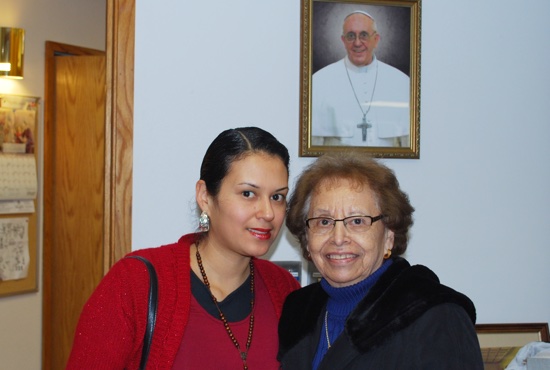
With anticipation and joy, Hispanic Catholics in the Archdiocese of St. Paul and Minneapolis had their hearts in Mexico for the last week, amid Pope Francis’ visit to the country Feb. 12-17.
“I think that the pope’s visit is going to bring peace, and that all the violence and kidnappings will stop,” said Ricarda Virruleta, 84, who attends Our Lady of Guadalupe in St. Paul and has lived in the U.S. for 46 years.
The pope visited Morelia in the state of Michoacán Feb. 16. The state is a hotbed of drug trafficking and kidnappings for ransom. One of Virruleta’s sons and three grandchildren live in Morelia, and though they haven’t experienced violence, there is always the threat, she said after Mass Feb. 14.
Mexico needs the pope’s message of mercy, said fellow parishioner Mayra Mendez, 30.
“We need God’s mercy in Mexico, like the psalm said today, because we are in these moments of tribulation,” she said.
On the afternoon of Feb. 12, knowing Pope Francis was arriving in the homeland of her parents, Mendez’s thoughts turned to Mexico and Our Lady of Guadalupe. She feels especially close to Pope Francis because of his devotion to Mexico’s patron saint.
“I was crying, singing to myself, ‘Madre, Mirame,’” she said. “I think as Hispanics, Mary has always looked on us with mercy. Mary looks at all of us, all of her children in America.”
“Madre, Mirame” (Spanish for “Mother, Look at Me”) is a hymn to Our Lady of Guadalupe.
Guillermo Maldona Perez and Leslie Gamez, young parents also at Mass Feb. 14, followed the pope’s visit on social media. Perez’s parents, who live in Ecatepec de Morelos, participated in the papal Mass Feb. 13 at the Basilica of Our Lady of Guadalupe in Mexico City.
“I am happy to see that people are happy to receive him even though social media has been negative,” Perez said.
Gamez and Perez said social media around the pope’s visit included contradictory remarks, with commenters not only criticizing the Mexican government for reportedly trying to convince Pope Francis to change his itinerary and not to speak out about the 43 missing students from Gerrero, but also denouncing the financial outlay of the government for the pope’s visit.
“It seemed more a criticism of religion,” she said.
For Gamez, it seemed strange to criticize government spending for the pope considering how much public money is lost to corruption. In contrast, she noted, Pope Francis only wants to do good, and since Mexico is an overwhelmingly Catholic country, many citizens want to see him.
“We never saw things like that with other popes,” said Perez, who was in Mexico for the apostolic visits of St. John Paul II.
Antonia Alvarez, co-founder of Assamblea de Derechos Civiles, a group that works for the rights of immigrants, and a parishioner of Sagrado Corazón de Jesús in Minneapolis, hopes Pope Francis’ visit to Mexico will not only strengthen people’s faith, but also bring reform to the Church and the government. She is originally from Mexico City and has lived in the United States for 15 years.
“It is very clear to me that these are the places the pope needs to go to,” she said, especially Chiapas and the border town of Ciudad Juarez. “In Chiapas, the large companies want to control all the natural resources and oppress the people. The problems of Chiapas are problems for everyone. Chiapas is one of the richest regions in Mexico, and it must be protected.”
The region boasts mineral deposits and coffee plantations and is home to many of Mexico’s poorest citizens. It also has a large indigenous population that garnered international attention in the 1990s through the Zapatista rebellion, a movement for greater local and indigenous control of land and mineral rights. Pope Francis celebrated Mass Feb. 15 with the indigenous community in Chiapas’ capital, San Cristobal de Las Casas.
Alvarez also hopes Pope Francis sends a strong message to Mexico’s priests to respect the people they serve, come closer to them and become involved in social justice issues.
“When I came to Unites States, I was mad at the Church,” Alvarez said, mostly because of priests in Mexico who seemed to care little about the social injustices that plagued the country.
Meeting American priests who embraced poverty helped her to recover her faith and see that “the Church is not just a business.”
Alvarez’s co-founder, Pablo Tapía, also a parishioner of Sagrado Corazón de Jesús, knows the pope’s visit is only the beginning.
“Wherever he goes, the effect is deep,” he said. “But the outcome of those effects, the inspiration he gives people, they have to turn them into faith in action.”



